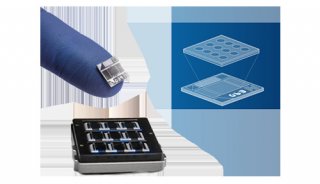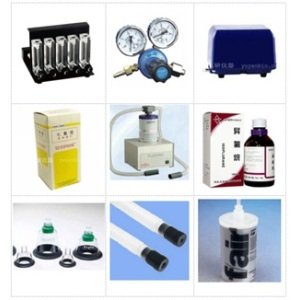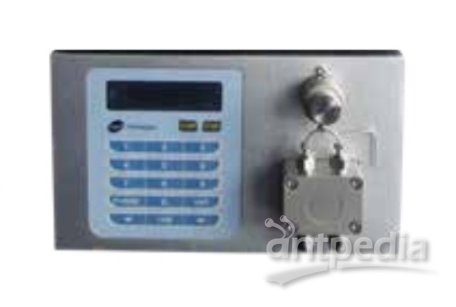Adrenal chromaffin granule (chromaffin vesicle) preparation
Adrenal chromaffin granule (chromaffin vesicle) preparation
Introduction.
This prep is adapted from the classic paper of Smith and Winkler (Smith AD; Winkler H. A simple method for the isolation of adrenal chromaffin granules on a large scale. Biochemical Journal, 1967 May, 103(2):480-2). The method is usually used to prepare granules from freshly obtained (never frozen!) bovine adrenal glands, but can also be used to prepare chromaffin granules from fresh human pheochromocytoma. We have modified this method slightly, mainly in using somewhat different centrifuge speeds and rotors, though preserving the product of (G force)(minutes) for any given centrifugal run. Most of the steps are done in the cold (0-4 oC), unless otherwise noted. You can work on a benchtop with an ice bucket and a glass beaker.
Protocol.
1. Obtain fresh adrenal glands from a local bovine slaughterhouse. We typically transport the glands back on water ice (i.e., 0oC). We've had good results on adrenals even several hours after death. We have used 20-70 adrenals per prep. If you use a large number of adrenals, increase the number of centrifuge tubes during the sucrose density step gradient run, so as not to overload the gradient.
2. Trim away the cortex and fat from the medullae. Put the medullae back in a beaker on ice.
3. Mince the medullae with a scissors. Put the minced medullae back in a beaker on ice. Weigh the minced medullae.
4. Homogenize the minced medullae in 5-10 volumes (based on weight) of cold 0.3 M (i.e., isotonic) sucrose. Typically, we use a Tissuemizer (or Ultraturrax), but you can also use a Polytron. These instruments have sharp blades that slice the tissue and thereby open the cells, rather than crushing the cells. With a Tissuemizer, you'll probably need ~1/2 power for 30-60 seconds. Homogenize until smooth.
5. Filter the homogenate through gauze or cheesecloth. We usually just use a J&J 4 in x 4 in gauze bandage ("4 by 4") from the hospital.
6. Spin the homogenate at 0oC to pellet nuclei and debris. 1000 G for 10 min (= 10,000 G min) is what we do. We use a refrigerated Sorvall centrifuge with a fixed angle rotor. Discard the pellet, keep the the super. We call this the low speed supernate (LSS).
7. Transfer the LSS to new tubes. Spin at 0oC at high speed to pellet a crude granule fraction. We typically use 10 KG for 20 minutes (= 200,000 G min), in a refrigerated Sorvall centrifuge with a fixed angle rotor. The crude granule fraction (pellet) contains chromaffin granules, mitochondria, and lysosomes. Save the pellet, and discard the supernate (which we call the high speed super, or HSS). The HSS contains cytosol, microsomes, etc.
8. Gently resuspend the crude granule pellet in cold 0.3 M sucrose. I use a pasteur pipette with gentle up and down aspiration, and a rubber policeman. Use enough volume so that you get a smooth suspension. For a 30 adrenal prep, I usually spspend into ~60-80 ml of volume.
9. Prepare the sucrose density step gradients. For a 30 adrenal prep, I usually make 6-8 tubes. Use ~40 ml tubes, and add 20 ml of 1.6 M sucrose to each. Keep chilled. Gently (without significant mixing) layer 10 ml of the resuspended granules (in 0.3 M sucrose) onto each 20 ml layer of 1.6 M sucrose.
10. Spin the gradients at 0-4 oC for 10 hours (or overnight) in a refrigerated centrifuge (we use a Sorvall and a fixed angle rotor) at 10 KG. This reproduces the number of (G)(min) achieved by a 100 KG spin for 1 hour (as originally used by Smith & Winkler), but I find that this 10K spin is more convenient. The number of G min is 6,000,000 G min. By this time, it's usually late in the day, and I want to leave the lab. This also avoids an ultracentrifuge step.
11. The next morning, stop the centrifuge. It's probably best if you do not use the brake, so as not to disturb the gradient. You should see the pink chromaffin granule pellet at the bottom of the tube. The pink color is probably from cytochrome b561 in the granule membrane. Mitochondria will be a brown layer at the 0.3/1.6 M interface. Whitish lysosomes will be at the interface, and a few will also penetrate the granule and lie on top of the granules. Gently pour off the gradient. Wipe the inside of each tube with a Kimwipe, to remove adherent specks of mitochondria from the interface region. Gently rinse the granule pellet with cold 0.3 M sucrose (this rinses off some lysosomes).
12. Lyse the granules into a total of 30 ml of cold hypotonic buffer. We typically use 1 mM Hepes pH 7, but we've also used distilled water, or 1 mM phosphate pH 6.5. Add the buffer, and resuspend the granules with a rubber policeman and a pasteur pipette. If the suspension is not homogeneous, homogenize it briefly with the Ultraturrax. Freeze the suspension (I just put it in a -70 o C freezer) and thaw, then put it on ice. Now you have lysed chromaffin granules (vesicles) plus membranes in solution. We call this CVL+M (chromaffin vesicle lysate plus membranes).
13. Spin out the granule membranes in the ultracentrifuge. I spin at 100 KG for 1 hour. The supernate is the chromaffin vesicle lusate (CVL, or CVL-M [CVL minus membranes]). STore it frozen at -70 degr C. The pink pellet is chromaffin vesicle membranes (CVM).
14. "Wash" the CVM. Resuspend the CVM in 30 ml cold 1 mM Hepes pH 7. Freeze and thaw as before, and ultracentrifuge as before. The supernate is membrane washings (we call them CVMW; they may be discarded). The pellet is washed CVM (store them at -70 oC).
References.
A. The original citation.
Smith AD; Winkler H. A simple method for the isolation of adrenal chromaffin granules on a large scale. Biochemical Journal, 1967 May, 103(2):480-2B. For our use of the prep for bovine (or rat) chromaffin granules, see:
O'Connor DT, Frigon RP: Chromogranin A, the major catecholamine storage vesicle soluble protein: multiple size forms, subcellular storage and regional distribution in chromaffin and nervous tissue elucidated by radioimmunoassay. J Biol Chem 259: 3237-3247, 1984. EM verification of prep.Takiyyuddin MA, Cervenka JH, Hsiao RJ, Barbosa JA, Parmer RJ, O'Connor DT. Chromogranin A: storage and release in hypertension. Hypertension 15: 237-246, 1990. Shows a rat chromaffin granule prep on a sucrose gradient.
Barbosa JA, Gill BM, Takiyyuddin MA, O'Connor DT: Chromogranin A: posttranslational modifications in secretory granules. Endocrinology 128:174-190, 1991.
O'Connor DT, Klein RL, Thureson-Klein AK, Barbosa JA: Chromogranin A: localization and stoichiometry in large dense core catecholamine storage vesicles from sympathetic nerve. Brain Research 567:188-196, 1991.
C. For our use of the prep for human pheochromocytoma granules, see:
O'Connor DT, Frigon RP, Sokoloff RL: Human catecholamine storage vesicle proteins. Clin Exp Hypertension A4(4&5): 563-575, 1982. Some EM.
O'Connor DT, Frigon RP, Deftos LJ: Immunoreactive calcitonin in catecholamine storage vesicles from human pheochromocytoma. J Clin Endocrinol Metab 56: 582-585, 1983.
Gozes I, O'Connor DT, Bloom FE: Sequestration of vasoactive intestinal polypeptide in pheochromocytoma chromaffin granules: a possible high molecular weight precursor. Regulatory Peptides 6: 111-119, 1983.
O'Connor DT, Frigon RP, Sokoloff RL: Human chromogranin A: purification and characterization from catecholamine storage vesicles of pheochromocytoma. Hypertension 6: 2-12, 1984. Some EM.
Parmer RJ, O'Connor DT: Enkephalins in human phaeochromocytoma: localization in immunoreactive high molecular weight form to the soluble core of chromaffin granules. J Hypertension 6: 187-198, 1988.
Hsiao RJ, Parmer RJ, Takiyyuddin MA, O'Connor DT: Chromogranin A storage and secretion: sensitivity and specificity for the diagnosis of pheochromocytoma. Medicine 70:33-45, 1991.
Gill BM, Barbosa JA, Dinh TQ, Garrod S, O'Connor DT: Chromogranin B: isolation from pheochromocytoma, N-terminal sequence, tissue distribution and secretory vesicle processing. Regul Peptides 33:223-35, 1991.
Syversen U, Waldum HL, O'Connor DT: Rapid, high-yield isolation of human chromogranin A from chromaffin granules of pheochromocytomas. Neuropeptides 22:235-240, 1992.
D. To isolate epi-rich versus norpri-rich chromaffin granules.
You can also set up sucrose density gradient conditions so as to separate norepi versus epi granules. This was first worked out by David Smith at Oxford (see below). The sucrose gradient is 0.3M/1.6M/2.05M. Epi granules cluster at the 1.6M/2.05M interface, while the denser norepi granules pass thru the entire gradient and pellet at the bottom of the tube. Using this approach, we found that CgA was enriched in the epi granules (versus the norepi granules). Or you can separate norepi versus epi granules on a continuous sucrose gradient.
Bartlett SF; Smith AD. Adrenal chromaffin granules: isolation and disassembly. Methods in Enzymology, 1974, 31(Pt A):379-89



















